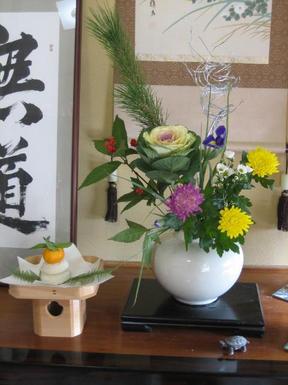 <The traditional Japanese New Year foods>
<The traditional Japanese New Year foods>SATE(Well), OSHOUGATSU(New Year holidays)
the parents' house
KONKAI TO JIKAI HA,(This time and next time,) I introduce a typical appearance
at OSHOUGATSU(New Year holidays)
WATASHI NO JIKKA HA, HEIBON NA KATEI DESUGA,
My parents' house
My parents are still GENKI(energetic)
The preparation(JUNBI) for the dish(RYOURI) and the decoration(KAZARITSUKE)
at OSHOUGATSU(New Year holidays)
Please read it like a feeling invited to the Japanese family
The upper photograph
WATASHINO HAHA HA, CHIISAI KORO KARA "IKEBANA" WO NARATTEIMASHITA.
My mother learned "flower arrangement
So she can arrange it for this much in around 5 minutes
ATTO IU MA DESU.
"SHASHIN
"Don't take a picture of it!
My mother said half in joke(JOUDAN).
Because this was not made well(JOUZU NI DEKINAKATTASHI)
and it is the flower
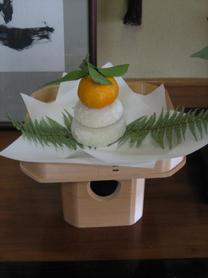
KOREHA, KAGAMI MOCHI DESU.
This is a round shaped rice-cake.
On a wooden stand(KI DE DEKITA DAI)
lay a paper(KAMI) on it.
SOSHITE, UE NI KAZARI MASU.
And you display it on the top.
NIHON HA, KI TO KAMI NO BUNKA GA ARIMASU.
Japan has culture of wood and paper.
SHIROI KAGAMI MOCHI HA, WATASHI NO JIKKA
The white rice cake was made at my parents' house.
I introduce OMOCHI RYOURI (The traditional rice cake dishes) on the next time.
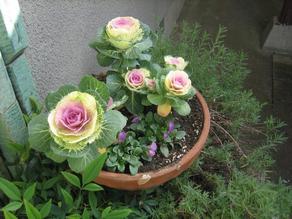
The flower (HANA)
of the photograph(SHASHIN)
HONTOU HA, KOREHA HANA DEHA NAKU HAPPA DESU
In fact(HONTOU HA), these are leaves
"HABOTAN" TO IU SHOKUBUTSU DESU.
It is an "ornamental cabbage
I think that it's the same kind(ONAJI SHURUI) as cabbages(KYABETSU).
Note) I don't think you can eat it. It is not edible
KORE HA, TABERAREMASEN.
My mother likes to decorate the entrance(GENKAN) according to the season.
Because it's a OSHOUGATSU(New Year)
These few days ago, the entrance was Christmas specifications
In Japan, we redecorate it hastily
ISOGASHII DESU NE.
Therefore the redecoration of the store seems to be also hard
TAIHEN DESU.
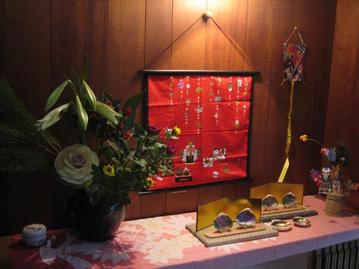
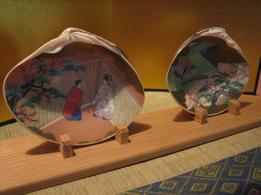 The decoration put toward you is called "KAI AWASE (Shellfish putting together)
The decoration put toward you is called "KAI AWASE (Shellfish putting together)It is traditional game(DENTOU TEKI NA ASOBI DESU.) to Japan
at HEIAN JIDAI(the Heian era) (1000 years or more ago).
A painting
Turn it over(HIKKUEIKAESHITE) and find the one with the same painting.
We play as a nervous breakdown(SHINKEI SUIJAKU) of card game
SOSHITE, OSECHI RYOURI(The traditional Japanese New Year foods.)
OSECHIRYOURI have a meaning in each.
FUTSUUHA (Usually), we display all food neatly in a
like this and put it on the dining table.
 Meaning that the prawn(EBI) lives long so that their back bends.
Meaning that the prawn(EBI) lives long so that their back bends.We also eat KAZUNOKO (herring roe), which is not in the photograph
KAZU means "number" and KO means "child".
It symbolizes a wish to be gifted with numerous children in the New Year.
SHISON HANEI(Descendant prosperity)
In the bean(MAME) dish, there is a wish that it is possible to live in "MAME(Diligence)".
MATA(In addition), food is good for two or three days
that the japanese woman does not need to do kitchen work
If it is the foreigner who got used to Japanese foods, because these foods are well seasoned with soy sauce and sugar, you may love all these dishes
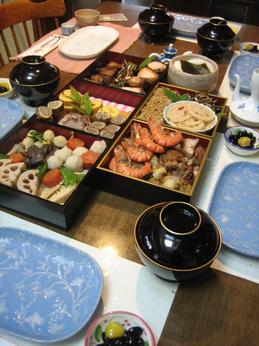 OSHOUGATSU NO GOCHISOU GA SEIZOROIDESU
OSHOUGATSU NO GOCHISOU GA SEIZOROIDESUThe feast of New Year holidays is an array, I only need to add rice cake food afterward.
WATASHI HA, OMOCHI GA DAISUKI DESU.
I love a rice cake!
At next week, I introduce how to eat rice cakes.
Please tell me about New Year
OSHIETE KUDASAI NE!!
Japanese Goods eBay Auction


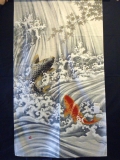
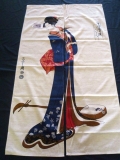
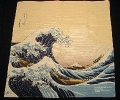
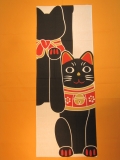


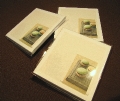


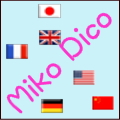
Everything looks extraordinary!
I'd like to taste the food, it looks simply delicious!
Thank you Miko-san!
Hi again
I loved reading about the japanese new year. As an aside, my mother too was a 'florist' and trained in the art of arranging flowers. I showed her you mother's arrangement and she was VERY impressed..she loved the seasonality of the arrangement and the balance..We both thought that your mum has an excellent eye for the art of Ikebana! The osechi-ryori bit also forced me to eat too much of my favourite food 'Shime Saba'...I am glutton for it and your page just made me run out and buy those mackerel....You have the most wonderful blog - please keep it up
Stephen
Thanky you.
I enjoy sharing pictures from
your familly life and beautifull
Japan.
Hi Miko!
You have such a big heart to share those information... I really learned a lot!Keep it coming
Arigatou:-)
Ana Gulica san,
It is taste so good.
I want you to taste it.
(^v^)
Stephen san,
doumo arigatou.
Thank you very much for your nice comment.
I like Shime saba too.
Please come and stop by again.
sayonara
(^o^)/
biljana san,
Thank you for your comment.
komento doumo arigatougozaimasu.
Mata asobini kite kduasai.
Please come again!!
Farah san,
dou itashimashite.
Thank you for your nice comment.
Please come again.
mata asobini kite kudasai ne.
(^v^)/~
In the meantime, if you’d like , please visit and/or comments on my blog: Okti Ragil Suharno Thanks in advance.Sincerely,
Yes this is great article, looking forward for update.
do-mo ARIGATOU! Thank you so much!
Well 1.0 has an end of life date now. July rather than March as you had suggested.